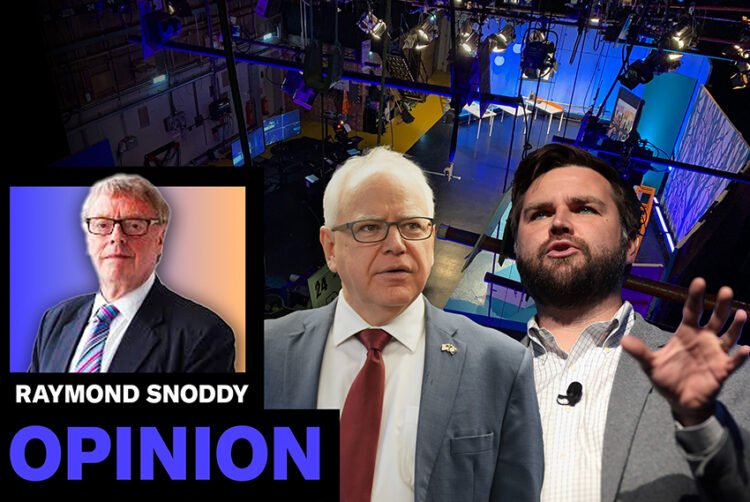The Springfield story is the ultimate media cautionary tale

Opinion
The Springfield cats and dogs debacle was an unchecked rumour that spread far and wide. As the presidential election campaign heads into the final stretch, US media has a responsibility to counter these kinds of unverified stories.
Haitian migrants, cats and dogs would almost certainly feature in the US vice-presidential debate on CBS on Tuesday.
After all, it was Donald Trump’s running mate JD Vance who was most responsible for spreading the untrue rumours that Haitians in Springfield, Ohio, had been stealing local pets and eating them. Vance even doubled down when told the story was false and claimed he had “created” the story to make a wider point about immigration.
If Vance decided to avoid further controversy over the issue, you can be certain that Kamala Harris’ running mate Tim Walz will remind the television audience of the cautionary tale about the man who could end up in the White House if the 78-year-old Trump were to win next month’s presidential election.
The ultimate media cautionary tale
Above all else, the Springfield controversy is a media story — or, more precisely, a new media story that went horribly wrong and led to security alerts and the demonising of a hard-working, entirely legal community.
It is the ultimate cautionary tale about the impact of unchecked, unverified rumours that get out to the wider world, aided by irresponsible politicians.
NewsGuard, the media-rating organisation, tracked the story back to its source and found the woman who in a private Facebook group wrote about a third-hand rumour from a neighbour regarding a cat that had disappeared.
Then, of course, Trump raised the cats and dogs of Springfield in front of a television audience of 67m in the US alone — and then it was off around the world and running.
NewsGuard has gone further and found that major brands in the US have been, presumably unknowingly, helping to fund the debunked falsehoods about the Haitian community.
Thanks to the joys of programmatic, ads from Amazon, Ticketmaster, AT&T, Kia and dozens of others have been appearing alongside the Springfield stories on multiple websites.
US media response
As we enter the final stretch of the US presidential election, with effects that could stretch far beyond the country, US media is still having problems dealing with an increasingly incoherent and deranged Trump.
Even respectable outlets like CNN are reporting sayings of Trump that are completely untrue.
In the past, there sometimes used to be a trace of a story in the claims of Trump, however exaggerated or taken out of context.
But now, as the Nobel economics laureate Paul Krugman wrote this week, Trump is talking about “an imaginary bad economy” when the markets are creating new records almost every day or “imaginary runaway crime” when the latest FBI numbers show both murders and violent crime in decline.
Then, Krugman added, there is also “the imaginary failure” of Joe Biden and Harris to respond to the current natural disaster.
Trump accused the president of refusing to take phone calls from Republican state governors seeking federal help to cope with the aftermath of Hurricane Helene. The governors involved said they had talked to the president and praised Biden for his swift response. Biden himself felt moved to accuse Trump directly of lying.
A never-before dilemma
In recent days, Trump has said some extraordinary things, even by his standards. He called for an hour of tough, violent policing, no questions asked. Some likened it to Kristallnacht, when the windows of Jewish businesses were smashed in Nazi Germany.
Such has been the normalisation of Trump by the media that the outrageous statement did not even make the front pages of the leading newspapers.
But how should the media react to something that has never happened before in US politics: a presidential candidate who repeatedly lies about his own performance, that of his political opponents and the facts about all the key issues facing society?
When Trump was flying high and a major box office draw, the networks and news channels were happy to show him live, and at length, for the sake of audiences and advertising revenue.
Now, as he rambles incoherently and even those who have not been paid to attend diminishingly small rallies start walking out, news channels are heading back to the studio, either in embarrassment or for fear of turning off viewers.
An act of duty from the media
Some time between now and 5 November, television channels should, as an act of public duty, show extended highlights of Trump rallies, complete with fact-checking, and allow voters to see the extent to which Trump has been mentally deteriorating — a process that appears to be accelerating as the campaign progresses.
It is time for papers such as The New York Times, which so resolutely criticised the age and declining powers of Biden, to apply the same standards to Trump, who is the oldest person in US history to run for president and who would be 82 by the end of his term, if elected.
At least the editorial board of The New York Times has now made its position clear. The paper said this week that Trump’s “first term was a warning” and that he is unworthy of the office. Harris has shown herself to be “a dedicated public servant”, setting out thoughtful plans to help US families, and the board endorsed her as “the only patriotic choice for president”.
Getting into its stride, the board argued that it was “hard to imagine a candidate more unworthy to serve as president of the US than Donald Trump”, before adding that he had made himself morally unfit for an office that asks its occupant to “put the good of the nation above self-interest”.
Fine words, but the US media as a whole has to stop treating Trump as a “normal” candidate when he is anything but.
Time is short.
 Raymond Snoddy is a media consultant, national newspaper columnist and former presenter of NewsWatch on BBC News. He writes for The Media Leader on Wednesdays — read his column here.
Raymond Snoddy is a media consultant, national newspaper columnist and former presenter of NewsWatch on BBC News. He writes for The Media Leader on Wednesdays — read his column here.




